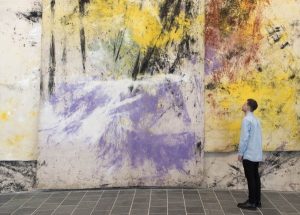Whilst thinking of a way to ‘devise a mode of practice’, artist Jessica Warboys came straight into my mind. She takes her work outside the studio and creates paintings whilst working on the beach. She does this by ‘casting mineral pigments directly onto a damp, folded canvas, which was then submerged under the sea before being pulled ashore.’ – (reference 1) This not only creates a spectacular display of colour (figure 2), but does so using natural resources.
Capturing what could be described as contemporary abstract art in such a unique way is truly what inspires me about her work. It could be argued that, as the waves are the ones making the impressions onto the folded canvas, nature itself is the true artist behind Warboys’ work. Here we’re not just looking at a 2D array of colour, but more importantly we are looking at array of energy powered behind a natural source which creates a dramatic display.
For me, this inspires me to question more upon what we are truly seeing when we view art. For this reason, my mode of practice would include altering and editing many processes of art together, to latch on to the idea that you should question what you see. As a simple example, I may start out creating a photo which I then work into with paint. Finally, I scan the artwork back into the computer to manipulate it once more. through the altering of a single image, it might become that it is no longer recognisable from what it once was – this would pose many questions and this process of editing and manipulating an image from a single point, is what I’d aim to focus on in my mode of practice.
Figure 2
Bibliography:
http://www.tate.org.uk/whats-on/tate-st-ives/exhibition/studio-and-sea/jessica-warboys
– Reference 1 and Figure 2, examples of Warboys mode of practice.

